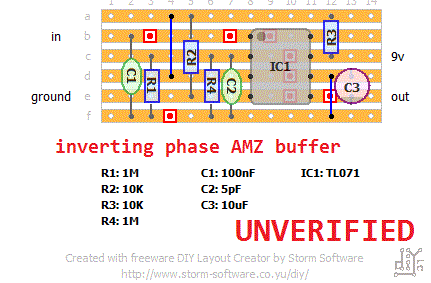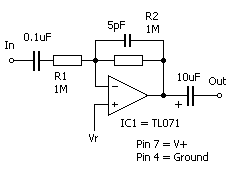Inverting Phase AMZ Buffer
|
Hello folks.
I've been looking for an easy and cheap way of inverting the phase of a signal coming in/from a pedal. I'll try to be brief: As English is not my natural language I feel that the more I try to explain the more I confuse the readers. I made this layout to achieve a way of blending a clean signal with an effected signal coming from a pedal which nature inverts the signal phase (Marshall Guv'nor for bass, in this particular case). Blending a signal (clean) with an equal (or similar, in fact) signal (effected) that is inverted will cause total or partial cancellation of frequencies, comb filters and strange sonic failures. I took this schematics from Muzique site. It's the last buffer of this page and its features are well explained. I'm posting it here to be sure I'm not wrong about the whole idea, and to be sure of the layout. If it's right I'd want to share it. I think it can be very helpful to a lot of people. Lots of questions about inverted phases in the "Split n blend" topic of the main site, for example. I think this buffer can be added before or after the effect. In the Split n Blend scenario it can be added: 1- between Send and effect's In. 2- between effect's Out and Return.  (Edit: Schematics added)  Thanks a lot! |
|
Administrator
|
This post was updated on .
Durrrrr
|
None of the transistor buffers on the AMZ page invert the phase. They are standard common collector (aka emitter follower) for bjt circuits and common drain (aka source follower) fet circuits. If you follow the links, you'll find they both have voltage gains close to 1. Circuits with inverted outputs have negative voltage gains. The often-used bjt and jfet circuits that have inverted outputs are common emitter and common source amplifiers, respectively. Note that the gains listed in the links are negative. The problem with using these circuits as simple inverters is that they are not buffers (their input impedances are too low, and their output impedances are too high). Their gains are derived from the emitter and collector resistors (source and drain resistors for the fet versions) and their internal gain factors, which can vary pretty wildly from device to device. It is possible to use one of these circuits as an inverter (with or without extra gain), but if you want them to be buffers, you have to put an extra buffer in front of them, and another one after them. Easier to use the inverting op-amp buffer. After you study these circuits a little bit, take a look at the AMZ Mosfet Booster at the bottom of this page. Note that if you want to use this circuit as a buffer, you have to use a switch to tap the output from the source instead of the drain. When you do this, the output will no longer be inverted. When it's in booster mode, it's not a buffer, even with the gain control at zero. |
|
Administrator
|
Well I just learned something! Thanks induction! I will edit my post to avoid confusion
|
|
In reply to this post by induction
Thanks for the answer, Induction (and Travis too, of course)
I don't know if I got it right... It's alright using this op-amp buffer as inverter? Do you (o anybody) think there are a better option? The specific use should be a bass signal coming into the Split n Blend, then using the SnB send/return to insert the Guv'nor. Obviously before or after the Guv'nor I'll need to insert the inverter. Thanks a lot. |
|
It looks good to me, except that I'd add some filtering to the Vref node. A 10u between rows d and e should do it (negative leg on row e).
I'd try it in conjunction with the Split'n'blend before you make your final decision about placement. I think you could add it to the input or the output of the Guv'nor without changing the tone very much on its own, but when you combine signals from parallel circuits, the relative output impedances of each circuit might have some audible effect. The send of the Split'n'blend is buffered, so the inverter probably won't have an audible impact in front of the Guv'nor, but the return of the Split'n'Blend is unbuffered. If the impedance adjustment is going to have a noticeable, it will be most obvious after the Guv'nor. So try it both ways and see which you prefer. If you can't hear a difference, I'd say put the inverter after the Guv'nor, just for the improved output impedance. You may also want to add an appropriate pulldown resistor, depending on how you implement the switching. |
|
Thanks a lot Induction. You're the man.
I'm going to update the layout with the adding of the filtering. Then I'll try all options and expose my results here. Cheers. |
«
Return to Unverified Layouts
|
1 view|%1 views
| Free forum by Nabble | Edit this page |

